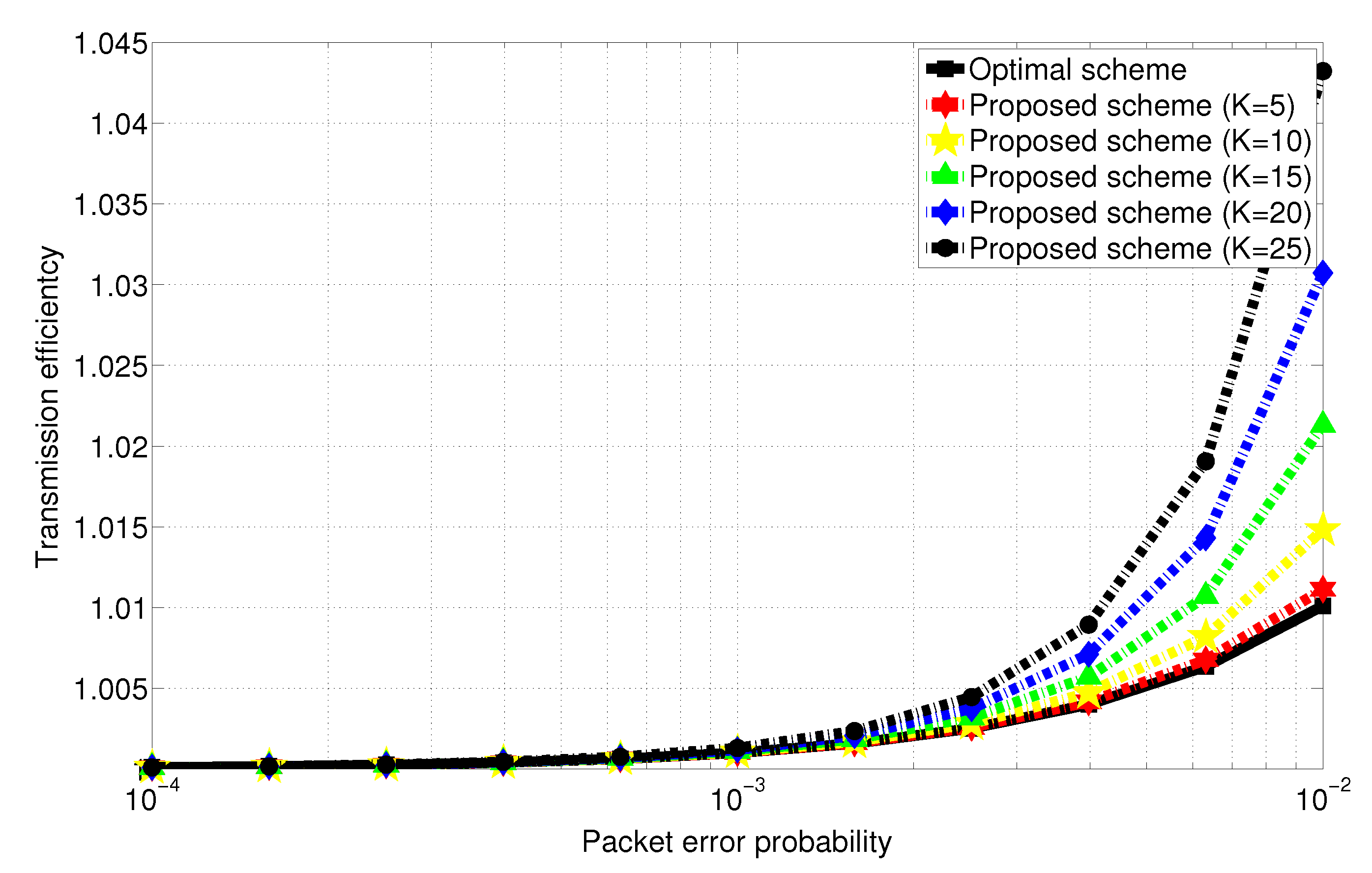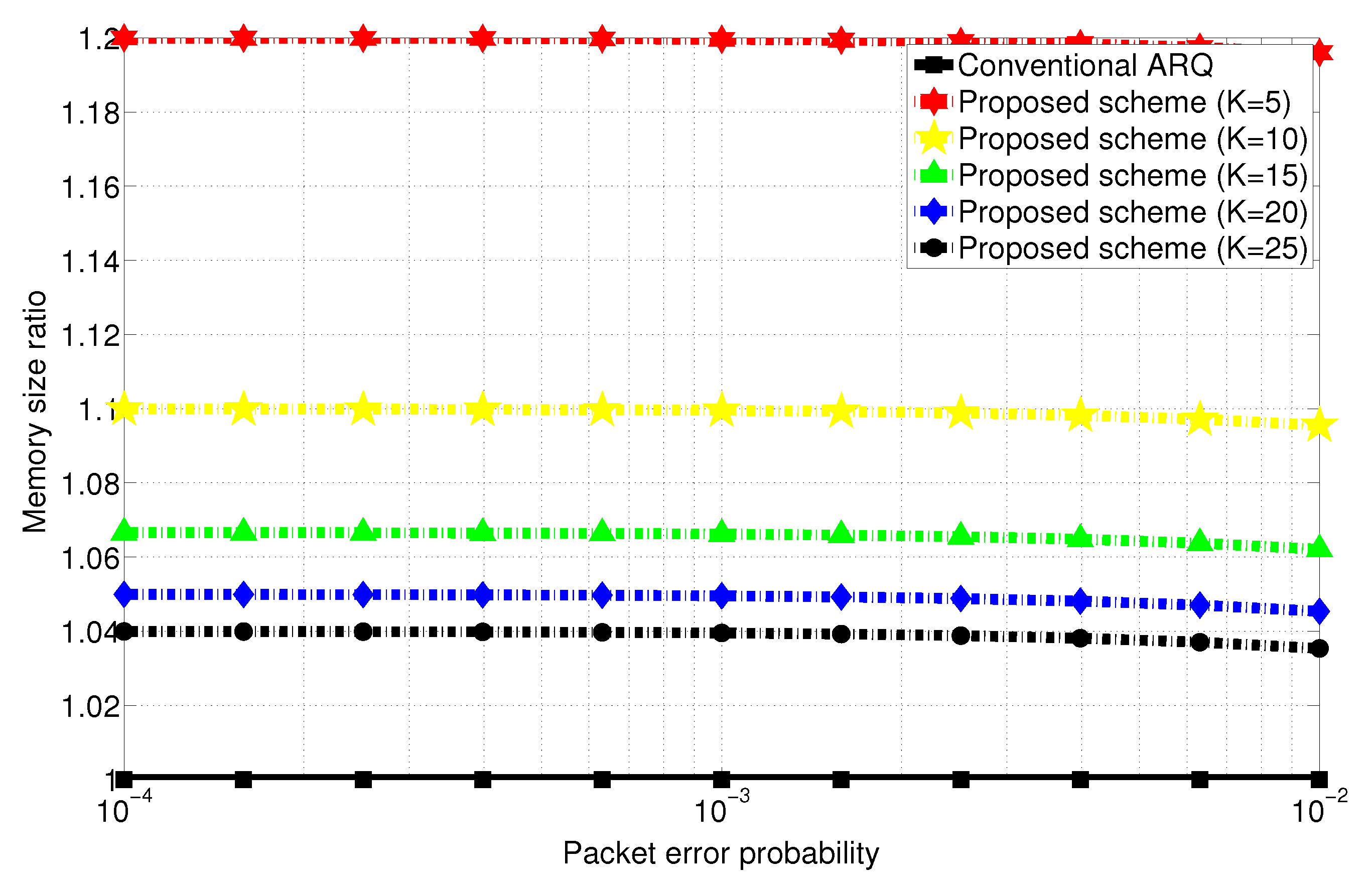Index Coded Automatic Repeat Request (ARQ)
Abstract
1. Introduction
2. System Model
- The first phase: Transmission of original N data packets
- The n-th phase: Retransmission of erroneous packets in the -th phase
3. Motivating Examples When and
3.1. When
- For the zero-th packet error pattern set, no index coding is feasible since there is no packet that is decoded successfully. Thus, the average number of retransmitted packets approachesfor sufficiently large N.
- For the 1-st packet error pattern set, the index coding can be utilized over two different packets for broadcasting in the two packet error pattern subsets of and . When denotes a packet in the subset of , the index-coded packet is given bywhere ⊕ represents the XOR operation. Here, the index coding is effectively used because each Rx has a successfully decoded packet in or .
- For the second packet error pattern set, there is no packet error event, resulting in no retransmission.
3.2. When
- For the zero-th packet errror pattern set, there is no side information from successfully decoded packets. Hence, the average number of retransmitted packets isfor sufficiently large N.
- For the first packet error pattern set, each Rx decodes packets only in one of packet error pattern subsets of , , and . Thus, based on the side information, the following index coding can be used at the Tx:where is a packet in the jth subset in the ith packet error pattern set. At the Rx side, three packets ’s with can be decoded successfully if more than or equal to 2 index-coded packets in Equation (6) is feasible. Consequently, the total number of retransmitted packets converges toasymptotically.
- For the second packet error pattern set, each Rx can use two successfully decoded packets in packet error pattern subsets of , , and so that the following index coding is applied:In this case, each Rx can decode packet if index-coded packet belongs to packet error pattern subsets of , , and and the index-coded packet in (8) is decoded successfully. Thus, the total number of retransmission packets converges toon average.
- For the third packet error pattern set, all packets are decoded successfully at each Rx. Thus, the total number of retransmitted packets is zero.
4. Disadvantages of Conventional ARQ and Naive Index Coded ARQ
4.1. Conventional ARQ with No Index Coding: Inefficiency in the Sense of Total Number of Transmission
4.2. Nave Index-Coded ARQ: Inefficiency in the Sense of Memory overhead
4.2.1. Memory Overhead When and
4.2.2. Memory Overhead for the General Case
5. Proposed Scheme: Simplified Index-Coded ARQ
5.1. Coding Scheme
- The 1-st phase: Transmission of original N packets is performed.
- From the 2-nd phase: If packets belonged in the packet error pattern set and its subsets of and , the following index coding is accomplished.Else, naive retransmission of corresponding packets is done. It is worthy noting that the packet error pattern is determined by the ACK and NACK pattern after the 1-st packet transmission.
5.2. Asymptotic Optimality in the Sense of the Transmission Efficiency
5.3. Reduction of Memory Overhead
6. Numerical Results
6.1. Transmission Efficiency
6.2. Memory Overhead
7. Conclusions
Funding
Conflicts of Interest
References
- Cover, T.M.; Thomas, J.A. Elements of Information Theory; John Wiley & Sons: New York, NY, USA, 1991. [Google Scholar]
- Verdú, S. Multiuser Detection; Cambridge University Press: New York, NY, USA, 1998. [Google Scholar]
- Birk, Y.; Kol, T. Coding on demand by an informed source (ISCOD) for efficient broadcast of different supplemental data to caching clients. IEEE Trans. Inf. Theory 2006, 52, 2825–2830. [Google Scholar] [CrossRef]
- Bar-Yossef, Z.; Birk, Y.; Jayram, T.; Kol, T. Index Coding with Side Information. In Proceedings of the 2006 47th Annual IEEE Symposium on Foundations of Computer Science (FOCS’06), Berkeley, CA, USA, 21–24 October 2006; pp. 197–206. [Google Scholar]
- Alon, N.; Lubetzky, E.; Stav, U.; Weinstein, A.; Hassidim, A. Broadcasting with side information. In Proceedings of the 2008 49th Annual IEEE Symposium on Foundations of Computer Science, Philadelphia, PA, USA, 25–28 October 2008. [Google Scholar]
- Effros, M.; Rouayheb, S.E.; Langberg, M. An equivalence between network coding and index coding. IEEE Trans. Inf. Theory 2015, 61, 2478–2487. [Google Scholar] [CrossRef]
- Ahlswede, R.; Cai, N.; Li, S.-Y.; Yeung, R. Network information flow. IEEE Trans. Inf. Theory 2000, 46, 1204–1216. [Google Scholar] [CrossRef]
- Lee, N.; Dimakis, A.G.; Heath, R.W., Jr. Index coding with coded side-information. IEEE Commun. Lett. 2015, 19, 319–322. [Google Scholar] [CrossRef]
- Xiao, X.; Lu-Ming, Y.; Wei-Ping, W.; Shuai, Z. A wireless broadcasting retransmission approach based on network coding approach to multicast. In Proceedings of the 2008 4th IEEE International Conference on Circuits and Systems for Communications, Shanghai, China, 26–28 May 2008; pp. 782–786. [Google Scholar]
- Nguyen, D.; Tran, T.; Nguyen, T.; Bose, B. Wireless broadcasting using network coding. IEEE Trans. Veh. Technol. 2009, 58, 914–925. [Google Scholar] [CrossRef]
- Asadi, B.; Ong, L.; Johnson, S.J. On index coding in noisy broadcast channels with receiver message side information. IEEE Commun. Lett. 2014, 18, 640–643. [Google Scholar] [CrossRef][Green Version]
- Lu, L.; Xiao, M.; Skoglund, M.; Wu, G.; Li, S. Efficiency network coding for wireless broadcasting. In Proceedings of the 2010 IEEE Wireless Communication and Networking Conference, Budapest, Hungary, 13–15 October 2010; pp. 1–6. [Google Scholar]
- Papadopoulos, A.; Georgiadis, L. Multiuser broadcast erasure channel with feedback and side information, and related index coding results. In Proceedings of the 2014 52nd Annual Allerton Conference on Communication, Control, and Computing (Allerton), Allerton House, IL, USA, 1–3 October 2014; pp. 1325–1332. [Google Scholar]
- Natarajan, L.; Hong, Y.; Viterbo, E. Lattice index coding for the broadcast channel. In Proceedings of the 2015 IEEE Information Theory Workshop (ITW), Jeju Island, Korea, 11–15 October 2015; pp. 1–5. [Google Scholar]
- Natarajan, L.; Hong, Y.; Viterbo, E. Index codes for the Gaussian broadcast channel using quadrature amplitude modulation. IEEE Commun. Lett. 2015, 19, 1291–1294. [Google Scholar] [CrossRef]
- Gray, R.M. Probability, Random Processes, and Ergodic Properties; Springer: New York, NY, USA, 2010. [Google Scholar]
- Csiszár, I.; Körner, J. Information Theory: Coding Theorems for Discrete Memoryless Systems; Academic: New York, NY, USA, 1982. [Google Scholar]
- Ho, T.; Médard, M.; Koetter, R.; Karger, D.R.; Effros, M.; Shi, J.; Leong, B. A random linear network coding approach to multicast. IEEE Trans. Inf. Theory 2006, 52, 4413–4430. [Google Scholar] [CrossRef]


| Packet error pattern set | ||||
| Packet error pattern subset | ||||
| 1st Rx | NACK | ACK | NACK | ACK |
| 2nd Rx | NACK | NACK | ACK | ACK |
| Packet error pattern set | ||||||||
| Packet error pattern subset | ||||||||
| 1st Rx | NACK | ACK | NACK | NACK | ACK | ACK | NACK | ACK |
| 2nd Rx | NACK | NACK | ACK | NACK | ACK | NACK | ACK | ACK |
| 3rd Rx | NACK | NACK | NACK | ACK | NACK | ACK | ACK | ACK |
| The Number of Rxs | ||||||
|---|---|---|---|---|---|---|
| Packet error probability | P = 0.001 | P = 0.01 | P = 0.1 | P = 0.001 | P = 0.01 | P = 0.1 |
| Optimal scheme (A) | 1.0010 | 1.0101 | 1.1111 | 1.0010 | 1.0101 | 1.1111 |
| Index coded ARQ (B) | 1.0010 | 1.0102 | 1.1234 | 1.0010 | 1.0104 | 1.1402 |
| 0.00 | 0.01 | 1.10 | 0.00 | 0.03 | 2.62 | |
© 2020 by the author. Licensee MDPI, Basel, Switzerland. This article is an open access article distributed under the terms and conditions of the Creative Commons Attribution (CC BY) license (http://creativecommons.org/licenses/by/4.0/).
Share and Cite
Choi, S.W. Index Coded Automatic Repeat Request (ARQ). Entropy 2020, 22, 869. https://doi.org/10.3390/e22080869
Choi SW. Index Coded Automatic Repeat Request (ARQ). Entropy. 2020; 22(8):869. https://doi.org/10.3390/e22080869
Chicago/Turabian StyleChoi, Sang Won. 2020. "Index Coded Automatic Repeat Request (ARQ)" Entropy 22, no. 8: 869. https://doi.org/10.3390/e22080869
APA StyleChoi, S. W. (2020). Index Coded Automatic Repeat Request (ARQ). Entropy, 22(8), 869. https://doi.org/10.3390/e22080869





